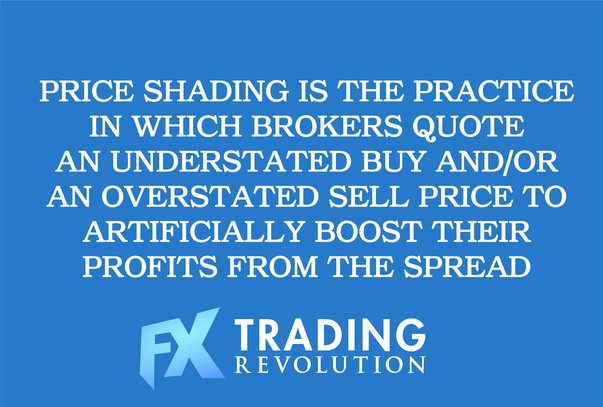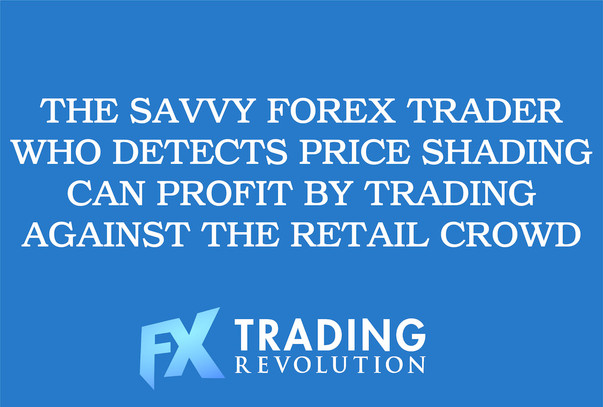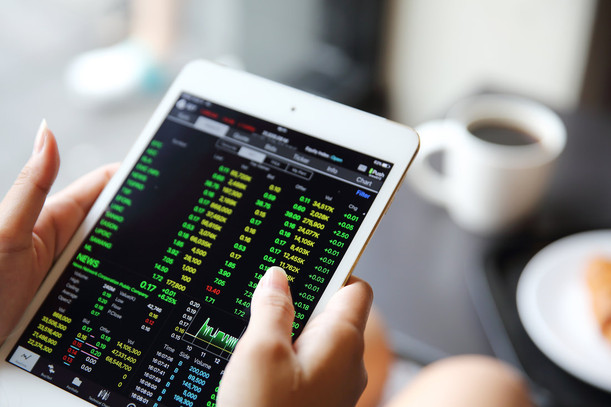When the term “price shading” is mentioned, it often conjures up pictures of an unscrupulous broker trying to pull a fast one on the trader.
And though this image may be accurate to some extent, the broker does not necessarily have to gain a lot at the expense of the trader and especially not against savvy Forex traders who know how to beat a broker at its own game.
What Exactly is Price Shading?
Price shading is the practice in which brokers quote an understated buy price and/or an overstated sell price to traders in order to artificially increase profits from the spread.
They do this by adding a few pips to the actual buy or deducting a few pips from the actual sell price as determined by interbank currency market.
In the majority of cases, whenever this happens, the retail forex traders are at a disadvantage since they are paying higher prices which negatively affects any profits which they make and also exaggerates any losses.
Still, if retail traders have an understanding of how price shading works, they have a window of opportunity to trade in such a way that they beat the broker at its own game and come out of the trade with an advantage.
The exchange rates of currencies are largely dependent on the activity that is taking place between large banks, hedge funds and large institutions on the spot forex market.
Depending on demand and supply forces, the currency rates are agreed upon and established constantly and at very fast speeds.

As we said earlier, shading occurs when the real interbank exchange rate is not the price that the broker passes on to the retail forex trader. Specifically, the broker, may add or deduct a few pips to create a margin and then quote that price to the retail trader.
For example, if the price that the broker receives for the GBPUSD currency pair is 1.2454 – 1.2455, the broker may quote a price of 1.2454 – 1.2456 or a price of 1.2453 – 1.2455. In both of these cases, the broker increased the spread to 2 pips instead of only 1, however as you may notice that will only be affecting some of its clients.
In the first case (1.2454 – 1.2456) the broker increased the buy price while keeping the sell price unchanged. In the second case (1.2453 – 1.2455) the broker made selling the pair more expensive while the buying price remained the same.
The broker determines which price to tweak based on the number of buy or sell orders it receives. If it receives a lot of buy orders it will increase the buy price and conversely a large inflow of sell orders will prompt the broker to lower the bid price (increase the price of selling the pair). This creates a price spread which de facto benefits the broker and puts the trader at a disadvantage.
The practice of price shading is based on the fact that the larger group of retail traders is usually wrong. The broker, therefore, aims to profit by both taking the other side of the position and also increasing the spread for the larger group of orders only.
By increasing the spread one way the broker can still retain having competitive and normal looking spreads even though it provides prices that are slightly different from the rest of the market. This is why price shading can be difficult to spot.
It’s interesting to note that brokers don’t shade prices only to boost profits, but also to offset their risk. Since theoretically, the larger group of traders that is either buying or selling can actually turn out to be right sometimes, it may end up costing the broker a lot or even losing money.
How Can a Trader Take Advantage of Price Shading?
If the trader is aware that price shading is occurring, he can take advantage by trading against the market. For instance, if the trader realizes that the broker is price shading with the view that it is a sellers’ market, the trader can try to profit by entering the market as a buyer based on the proven theory that the majority of retail traders are usually wrong.
Although it is possible to ascertain whether a broker is engaging in price shading or not, it is a difficult undertaking. The retail trader who wants to do this would have to gain access to a professional trading terminal that is directly connected to the interbank market, like Reuters or Bloomberg (or using the trading platform of the retail forex broker with true interbank market quotes).
By getting access to the real prices in the interbank market the trader can compare them with the prices he gets from his broker.
Another option is to open accounts with two brokers – one which does “straight-through-processing” and another that has a dealing desk. By doing this, the trader would be able to tell whether a broker is engaged in price shading.
The trader would also be able to tell which side of the market the broker is trading on and so trade accordingly. Brokers who use straight through processing usually do not engage in price shading but instead, they charge a small commission on each trade.
Trading on the broker’s side may be psychologically difficult for the trader since the position that the broker takes is usually the opposite to the position that the majority of traders take.

Therefore, the trader who wants to benefit from price shading would essentially be trading contrary to how his analysis tells him to trade. If a trader’s technical analysis tells him to sell, and the majority of trader’s take the same view, that trader may instead profit by actually placing a buy order rather than a sell order as the usual technical analysis signals.
Why Does Price Shading Take Place in Forex trading?
Price shading takes place because unlike the stock market, Forex is a decentralized market in which prices are determined by buying and selling between the “big sharks” - large buyers and sellers which are most often the largest banks in the world. In turn, unfair brokers have the freedom to manipulate that price to their own advantage.
While price shading may seem unscrupulous, there is nothing illegal about it. It is a way that some brokers choose to make extra profits from the Forex services they offer. And at the bottom line, except for very short-term traders, the end results of the trader are unlikely to be hugely affected by price shading of a few pips.
Price shading should not be confused with price slippage though.
Slippage is what tends to occur in the Forex market when the market is highly volatile. Because of the high volatility, a trader may not be able to open a trade at the exact price that they want to because prices are moving so quickly.
So, by the time they have placed the trade, the price may have moved up or down by a few pips and the desired price is simply not available anymore. Some ways to avoid slippage is to restrict trading to less volatile markets and to avoid trading during volatile news releases or to find an ECN broker that provides very fast order execution and true interbank market liquidity.
Conclusion
Even though the practice may appear to put the average trader at a disadvantage, the savvy Forex trader can in fact profit from price shading. The trader who detects price shading can repeatedly profit trading against the crowd and on the broker’s side, sometimes even at the expense of the broker.





